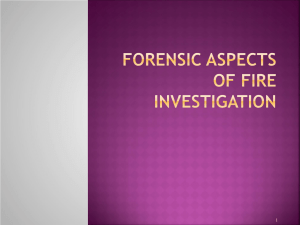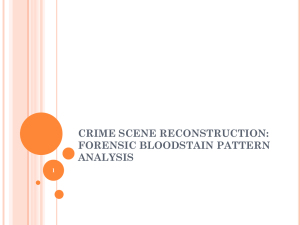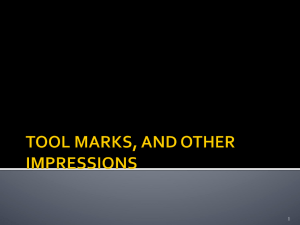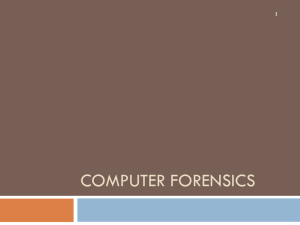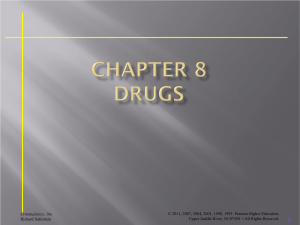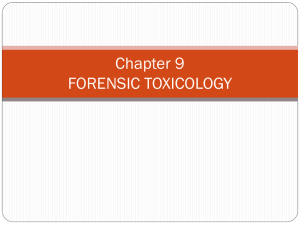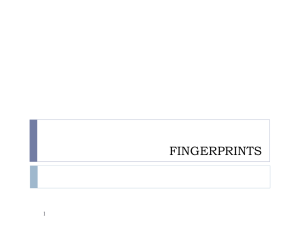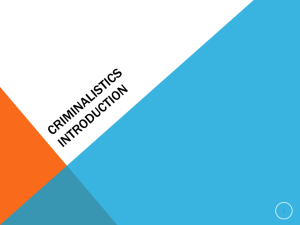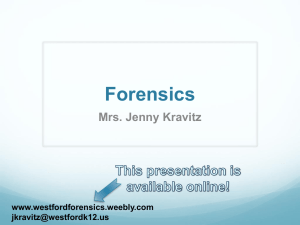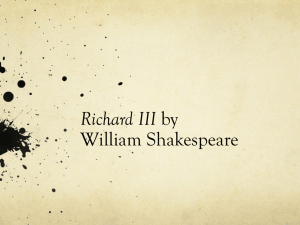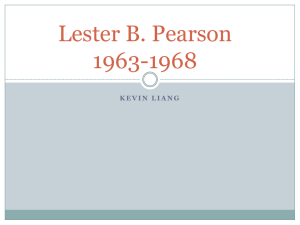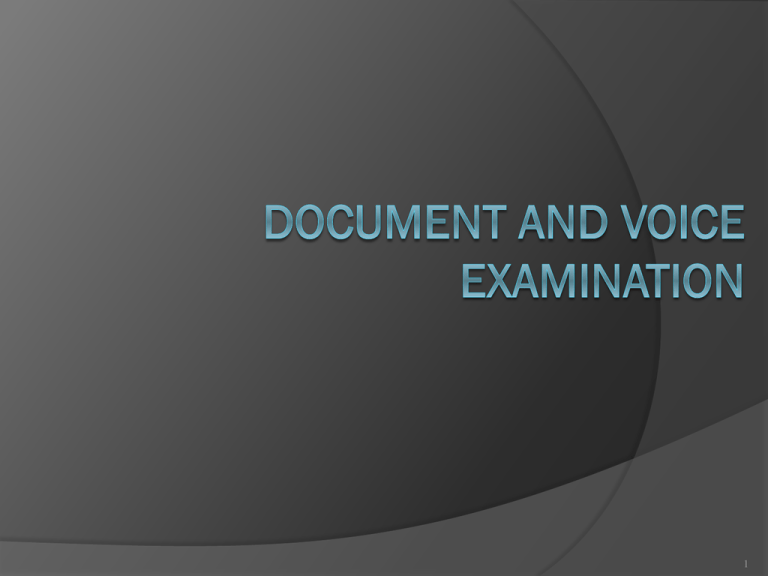
1
Introduction
Any object with handwriting or print whose
source or authenticity is in doubt may be referred
to as a questioned document.
Document examiners apply knowledge gathered
through years of training and experience to
recognize and compare the individual
characteristics of questioned and known
authentic writings.
For this purpose, the gathering of documents of
known authorship or origin is critical to the
outcome of the examination.
The uniqueness of handwriting makes this type
of physical evidence one of the few definitive
individual characteristics available.
Criminalistics, 10e
Richard Saferstein
© 2011, 2007, 2004, 2001, 1998, 1995 Pearson Higher Education,
Upper Saddle River, NJ 07458. • All Rights Reserved.
18-2
Character of Handwriting
Document experts continually testify to the
fact that no two individuals write exactly alike.
Many factors comprise the total character of
a person’s writing.
The early stages of learning handwriting are
characterized by a conscious effort to copy
standard letter forms.
However, as writing skills improve, nerve and
motor responses associated with the act of
writing become subconscious.
The unconscious handwriting of two different
individuals can never be identical.
Criminalistics, 10e
Richard Saferstein
© 2011, 2007, 2004, 2001, 1998, 1995 Pearson Higher Education,
Upper Saddle River, NJ 07458. • All Rights Reserved.
18-3
Character of Handwriting
Variations are expected in angularity, slope,
speed, pressure, letter and word spacing,
relative dimensions of letters, connections, pen
movement, writing skill, and finger dexterity.
Other factors to consider include the
arrangement of the writing on the paper, such as
margins, spacing, crowding, insertions, and
alignment.
Spelling, punctuation, phraseology, and grammar
can be personal and help to individualize the
writer.
Furthermore, the writing style of one individual
may be altered beyond recognition by the
influence of drugs or alcohol.
Criminalistics, 10e
Richard Saferstein
© 2011, 2007, 2004, 2001, 1998, 1995 Pearson Higher Education,
Upper Saddle River, NJ 07458. • All Rights Reserved.
18-4
Character of Handwriting
No single handwriting characteristic can in
itself be taken as the basis for a positive
comparison.
The final conclusion must be based on a
sufficient number of common characteristics
between the known and questioned writing
samples.
There are no hard and fast rules for a
sufficient number of personal characteristics;
it is a judgment call made by the expert
examiner in the context of each case.
Criminalistics, 10e
Richard Saferstein
© 2011, 2007, 2004, 2001, 1998, 1995 Pearson Higher Education,
Upper Saddle River, NJ 07458. • All Rights Reserved.
18-5
Handwriting Exemplars
The collection of an adequate number of known
writings (exemplars) is most critical for
determining the outcome of a handwriting
comparison.
Known writing should contain some of the words
and combination of letters present in the
questioned document and be adequate in
number to show the range of natural variations
in a suspect’s writing.
The writing implement and paper should also be
alike.
The writing of dictation and several pages may
serve to minimize attempts at deception.
Criminalistics, 10e
Richard Saferstein
© 2011, 2007, 2004, 2001, 1998, 1995 Pearson Higher Education,
Upper Saddle River, NJ 07458. • All Rights Reserved.
18-6
Typewriters and Printing Devices
The two requests most often made of the
examiner in connection with the examination
of typewriters and printing devices are:
Whether the make and model of the typewriter and
printing devices used to prepare the questioned
document can be identified
Whether a particular suspect typewriter or printing
device can be identified as having prepared the
questioned document.
In order to do this, the individual type
character’s style, shape, and size are
compared to a complete reference collection
of past and present typefaces.
Criminalistics, 10e
Richard Saferstein
© 2011, 2007, 2004, 2001, 1998, 1995 Pearson Higher Education,
Upper Saddle River, NJ 07458. • All Rights Reserved.
18-7
Characteristics From Use
As is true for any mechanical device, use of a
printing device will result in wear and damage
to the machine’s moving parts.
These changes will occur in a fashion that is
both random and irregular, thereby imparting
individual characteristics to the printing
device.
The document examiner has to deal with
problems involving business and personal
computers, which often produce typed copies
that have only subtle defects.
Another area of investigation relates to the
typewriter ribbon, which may contain type
impressions.
Criminalistics, 10e
Richard Saferstein
© 2011, 2007, 2004, 2001, 1998, 1995 Pearson Higher Education,
Upper Saddle River, NJ 07458. • All Rights Reserved.
18-8
Digital Technology
In the cases of photocopiers, fax machines, and
computer printers an examiner may be called on to
identify the make and model of a machine or to
compare a questioned document with test samples
from a suspect machine.
A side-by-side comparison is made between the
questioned document and the printed exemplars to
compare markings produced by the machine.
Examiners compare transitory defect marks, fax
machine headers, toner, toner application methods,
and mechanical and printing characteristics.
Criminalistics, 10e
Richard Saferstein
© 2011, 2007, 2004, 2001, 1998, 1995 Pearson Higher Education,
Upper Saddle River, NJ 07458. • All Rights Reserved.
18-9
Alterations
Document examiners must deal with
evidence that has been changed in
several ways, such as through alterations,
erasures, and obliterations.
Erasures by rubber erasers, sandpaper,
razor blade, or knife to remove writing or
typing disturb the fibers of the paper and
are readily apparent when examined with
a microscope.
If an alteration is made to a document with
ink differing from the original, it can
sometimes be detected due to differences
in the luminescence properties of the inks.
Criminalistics, 10e
Richard Saferstein
© 2011, 2007, 2004, 2001, 1998, 1995 Pearson Higher Education,
Upper Saddle River, NJ 07458. • All Rights Reserved.
1810
Alterations
Obliteration of writing by overwriting or
crossing out to hide the original writing
can be revealed by infrared radiation,
which may pass through the upper layer of
writing while being absorbed by the
underlying area.
Digital image processing is the method by
which the visual quality of digital pictures
is improved or enhanced.
Digitizing is the process by which the
image is stored into memory.
Criminalistics, 10e
Richard Saferstein
© 2011, 2007, 2004, 2001, 1998, 1995 Pearson Higher Education,
Upper Saddle River, NJ 07458. • All Rights Reserved.
1811
Alterations
An image can be scanned by scanner or a
digital camera and converting the image
by computer into an array of digital
intensity values called pixels.
Once the image has been digitized, an
image editing program can be used to
make adjustments such as lightening,
darkening, color, and contrast controls.
Using a photo editor on a digitized image
can reveal information that has been
obscured.
Criminalistics, 10e
Richard Saferstein
© 2011, 2007, 2004, 2001, 1998, 1995 Pearson Higher Education,
Upper Saddle River, NJ 07458. • All Rights Reserved.
1812
Other Problems
Infrared photography and reflecting light at
different angles are sometimes
successfully used to reveal the contents of
a document that has been accidentally or
purposely charred in a fire.
In certain situations, indented writings
(partially visible depressions underneath
the visible writing) have proved to be
valuable evidence.
It may be possible to determine what was
written by the impressions left on a paper
pad.
Criminalistics, 10e
Richard Saferstein
© 2011, 2007, 2004, 2001, 1998, 1995 Pearson Higher Education,
Upper Saddle River, NJ 07458. • All Rights Reserved.
1813
Other Problems
Applying an electrostatic charge to the
surface of a polymer film placed in contact
with a questioned document will visualize
indented writings.
A study of the chemical composition of the
ink used on documents may verify
whether or not known and questioned
documents were prepared by the same
pen; and the paper itself may be analyzed.
Criminalistics, 10e
Richard Saferstein
© 2011, 2007, 2004, 2001, 1998, 1995 Pearson Higher Education,
Upper Saddle River, NJ 07458. • All Rights Reserved.
1814
Voice Examination
The human voice may prove to be
valuable evidence for associating an
individual with a criminal act.
The probability that any two individuals:
Will have the same size vocal cavities
○ (Throat, nasal, and two oral cavities formed by
positioning the tongue)
Will coordinate their articulators
○ (Lips, teeth, tongue, soft palate, and jaw
muscles)
In a like manner is so small as to make the
human voice a unique personal trait.
Criminalistics, 10e
Richard Saferstein
© 2011, 2007, 2004, 2001, 1998, 1995 Pearson Higher Education,
Upper Saddle River, NJ 07458. • All Rights Reserved.
1815
The Sound Spectrograph
The sound spectrograph is an instrument
that converts speech into a visual graphic
display, called a spectrogram or voiceprint.
Courts have been asked to accept its
results as evidence of an individual’s
participation in a crime.
At this time, however, there are still
conflicting opinions in the courts as to
whether the voiceprint has gained a
sufficient degree of general acceptance
within the scientific community to satisfy its
admissibility as scientific evidence.
Criminalistics, 10e
Richard Saferstein
© 2011, 2007, 2004, 2001, 1998, 1995 Pearson Higher Education,
Upper Saddle River, NJ 07458. • All Rights Reserved.
1816
The Sound Spectrograph
The spectrum portrays three parameters of
speech: time, frequency, and the relative
intensity or volume.
When sufficient similarity exists between the
questioned and the known voice, a positive
conclusion is justified that both voices have
emanated from the same person.
The recent introduction of the computerized
sound spectrograph simplifies the work
today.
Criminalistics, 10e
Richard Saferstein
© 2011, 2007, 2004, 2001, 1998, 1995 Pearson Higher Education,
Upper Saddle River, NJ 07458. • All Rights Reserved.
1817
The Sound Spectrograph
Examiners apply both aural and visual
techniques when comparing two voice
samples.
The examiner can than classify the recording
into one of seven categories ranging from a
positive identification, a probable
identification, a possible identification,
inconclusive, a possible elimination, a
probable elimination, or a positive
elimination.
Criminalistics, 10e
Richard Saferstein
© 2011, 2007, 2004, 2001, 1998, 1995 Pearson Higher Education,
Upper Saddle River, NJ 07458. • All Rights Reserved.
1818
Review Questions 1-6
What activity is critical to the outcome of document
examination and why is it so important?
List three characteristics of handwriting, as well as three
characteristics of writing not related to handwriting, that a
examiner compares when studying a questioned
document.
List three factors that can make it difficult for an examiner
to determine the author of a questioned writing.
Why might a traced signature be more easily detected as
a forgery than one that is copied freehand?
List three characteristics of exemplars that should be as
alike as possible to the questioned document.
What individual characteristics are most valuable for
proving the identity of a typewriter?
Criminalistics, 10e
Richard Saferstein
© 2011, 2007, 2004, 2001, 1998, 1995 Pearson Higher Education,
Upper Saddle River, NJ 07458. • All Rights Reserved.
1819
Review Questions 7-12
What kinds of marks can a document examiner use to
identify the machine that produced a photocopy? What
information is used to identify the machine that produced
a fax copy?
What class characteristics can an examiner study to help
identify a suspect photocopy machine?
What is infrared luminescence? Describe how it can be
used to detect alterations or erasures in a document.
Describe two methods used to recover writing from
charred documents.
Describe two methods used to read indented writing.
From what substances are most commercial inks made?
What technique is used to compare inks? What
characteristic provides points of comparison between
different inks?
Criminalistics, 10e
Richard Saferstein
© 2011, 2007, 2004, 2001, 1998, 1995 Pearson Higher Education,
Upper Saddle River, NJ 07458. • All Rights Reserved.
1820

